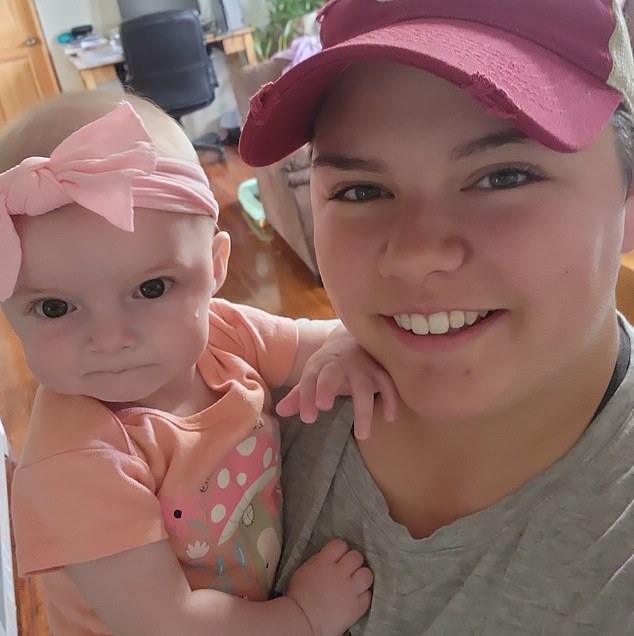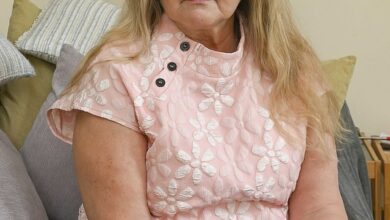I was 12 when I got a brain-eating amoeba and was in a coma for a month – I’m one of only 5 people to ever beat an infection






A mother of one tells how she overcame her fear of water after nearly dying as a child from a brain-eating amoeba she caught while swimming.
Kali Hardig of Arkansas was 12 years old when she fell into a lake and water entered her nose, exposing her to the brain-eating amoeba Naegleria fowleri.
A few hours after the accident, the girl suffered from a mild headache, but within 24 hours she was rushed to Arkansas Children’s Hospital in Little Rock, barely conscious.
A lumbar puncture revealed that she primary amoebic meningoencephalitis (PAM), or severe brain inflammation, caused by the amoeba.
The infection kills nearly 100 percent of people infected with it.
Mrs. Hardig was in a coma for a month and, through intensive treatment, became one of only five people in the US to survive the infection since 1978.

Kali Hardig, 23, pictured above with her 1-year-old daughter Adalynn, said the infection left her afraid of water for more than a year

Ms. Hardig is pictured above after recovering from the infection at Willow Springs Water Park, where she says she contracted the amoeba
Doctors at the hospital initially tried to turn Mrs. Hardig away because she had the flu, but her mother wouldn’t take no for an answer and demanded that she be tested for other infections.
They initially thought she had meningitis, an inflammation of the protective membranes covering the brain, because of her neck pain and her sensitivity to light.
But the lumbar puncture, which takes fluid from the spinal canal, showed that she did indeed have an amoeba infection.
Although she has now fully recovered, she occasionally experiences blurred vision in her left eye due to scar tissue left over from the disease.
“I do experience some blurry vision occasionally, but that’s the only lasting effect I experience from it,” she said.
When she was first diagnosed in July 2013, doctors told her parents the infection was a “death sentence” and that she had less than a one percent chance of survival.
They said she would likely die before the weekend and that if she survived, she would have to be in a wheelchair for the rest of her life.
She told PEOPLE: ‘They didn’t tell me at the time, they just said I was very sick and had to fight.
I had never heard of it before [the amoeba]and no one in my family either.’
To treat her, doctors initially placed her in a medically induced coma, which can help reduce inflammation and swelling in the brain and protect the organ.
They then administered anti-amoeba drugs, including the drug miltefosine, which had to be flown from Germany to the US.
After 22 days, doctors managed to restore the girl’s coma and she spent another month in hospital for further treatment.
After 55 days, Mrs. Hardig had recovered enough to be transferred to a rehabilitation center.

Mrs Hardig said that after she overcame the infection she was like a newborn baby and had to relearn everything, including the ability to walk and talk.

She also said that at the rehabilitation center they addressed her fear of water and eventually allowed her to swim in the center’s pool again.
She said she felt “like a newborn baby” at the time and had to relearn everything, including talking and, what she found most difficult, learning to walk again.
When she had just recovered, her parents explained to her that she had contracted the infection through water, which immediately made her afraid to even shower.
“After my parents told me how I got sick, I didn’t want to have anything to do with water anymore. I didn’t even dare to take a shower,” she wrote.
‘I was so scared, so during therapy they worked with me to calm me down in the pool at the children’s hospital.’
This included explaining to her that the water had been thoroughly treated with chemicals and that the amoeba would therefore not be in it.
Mrs Hardig, now 23 and a receptionist, said she was “happy” to have overcome her fear as she had enjoyed swimming before her illness.
She is also grateful that she overcame her fear of water so she can teach her one-year-old daughter, Adalynn, to swim, although she says she will always tell her to wear a nose clip.

N. fowleri kills about 97 percent of everyone it infects and is deadly because it quickly spreads to the brain and begins killing tissue
Naegleria fowleri lives in warm freshwater sources, such as lakes and rivers, and can infect a person if he or she gets contaminated water in the nose.
Once an infection begins, the amoeba travels via the olfactory nerve to the brain, where it causes widespread inflammation and damage to the organ. This is called primary amoebic meningoencephalitis (PAM).
Warning signs of an infection include a splitting headache, high fever, stiff neck, and confusion.
According to the CDC, more than 97 percent of patients die from the infection, and many of those who survive are left with lifelong disabilities.
The infections are very rare, with only about 10 recorded cases per year. Data shows that 157 people in the US have been previously infected since 1978, of whom only five survived, According to the CDCincluding Mrs. Hardig.
No cases of the amoeba have been reported in the US this year, but in Israel, a 25-year-old man reportedly died from the infection after swimming in the Sea of Galilee, a freshwater lake in the country.
In 2023, a child in Arkansas and a Georgia resident died from the infection after swimming in freshwater.




